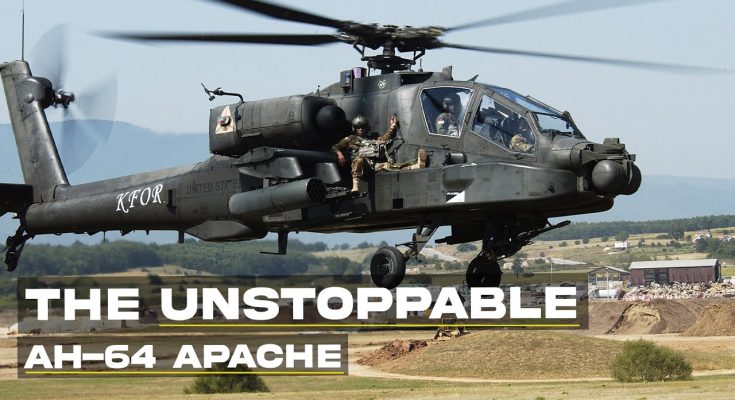The AH-64 Apache helicopter is often regarded as one of the most formidable attack helicopters ever built. Developed by McDonnell Douglas (now part of Boeing) in the 1970s, the Apache has become synonymous with modern combat, offering firepower, versatility, and durability in some of the most challenging environments. Known for its ability to engage a wide range of targets in various scenarios—whether on the battlefield, in air-to-ground combat, or in close-air support—the Apache has earned its reputation as unstoppable in modern warfare.
Design and Armament: Built for Combat
The Apache’s design was carefully crafted to ensure maximum combat efficiency and survivability. The helicopter features a tandem-seat configuration with the pilot in the rear and the gunner in the front. This setup allows the crew to operate in tandem for optimal effectiveness in high-pressure situations. The cockpit is heavily armored, providing protection from small-arms fire and shrapnel, ensuring that the crew can continue operations even under hostile fire.
The AH-64 is armed with a combination of hellfire missiles, Hydra 70 rockets, and a 30mm M230 chain gun mounted under the fuselage, making it an extremely lethal asset for attacking armored vehicles, fortifications, and infantry. Its ability to fire laser-guided missiles with pinpoint accuracy allows it to take out high-value targets at a long range, while the chain gun provides a more immediate, close-range solution for targets that need to be eliminated in seconds.
The Apache can carry up to 16 Hellfire missiles, a weapon designed specifically for anti-tank missions. The Hellfire missile is a game-changer, capable of hitting targets up to 8 kilometers away with extreme accuracy, guided by laser or radar systems. This makes the Apache incredibly effective against enemy armored vehicles, including tanks and other ground targets.
Advanced Technology: Eyes in the Sky
One of the defining features of the AH-64 Apache is its sophisticated avionics and sensor systems, which allow it to perform day and night operations under all weather conditions. The Apache is equipped with advanced Target Acquisition and Designation Systems (TADS), Pilot Night Vision Systems (PNVS), and Longbow Radar systems. These technologies give the Apache a significant edge in combat, as the systems provide real-time intelligence, target tracking, and targeting information, which can be shared with other assets on the battlefield.
The Longbow Radar system, for example, is a millimeter-wave radar mounted on the Apache’s nose that enables it to track and target up to 128 targets simultaneously, giving the crew an almost unmatched ability to identify and neutralize threats in various combat environments. The Apache can operate effectively in nighttime or adverse weather conditions, which is critical when engaging enemy forces who may attempt to hide in challenging terrains or during poor visibility.
Combat Performance: Unyielding in the Field
The Apache has seen combat in numerous conflicts, from the Gulf War to Iraq, Afghanistan, and other theaters of war. Its effectiveness in these conflicts solidified its reputation as one of the most reliable and lethal helicopters in the world. During the Gulf War (1991), Apache helicopters destroyed hundreds of Iraqi tanks and armored vehicles, proving their worth on the battlefield.
The Apache’s ability to operate at low altitudes, often flying under the radar to avoid detection, makes it a valuable asset for close-air support missions. It can fly just above the treetops, making it hard for enemy radar systems to pick it up. This tactic allows Apache crews to engage enemy forces with devastating surprise and speed. Furthermore, the Apache is equipped with self-protection systems like flare dispensers, jammer systems, and infrared countermeasures to defend itself against enemy missiles, increasing its survivability during engagements.
Durability and Survivability: Built to Last
One of the most remarkable aspects of the Apache is its survivability. The helicopter is designed with a highly durable structure that includes reinforced rotor blades and a crash-resistant fuselage. This allows the Apache to continue flying even if it sustains significant damage. The cockpit is well-protected by ballistic armor, and vital components of the helicopter, including engines and avionics, are protected by armored shielding. This ensures that the Apache has a high chance of making it back to base even after heavy damage.
For instance, during combat missions in Afghanistan, Apache helicopters have been shot down or severely damaged and yet have managed to fly back to safety, showcasing their resilience. The Apache’s ability to keep flying after sustaining damage makes it an invaluable asset to military forces, as it can continue to engage targets and complete missions under the most extreme conditions.
A Legacy of Unstoppable Power
The AH-64 Apache is more than just a helicopter; it is a symbol of combat superiority. With its lethal armament, advanced technology, and remarkable durability, the Apache has earned its title as the unstoppable force in modern warfare. From its unmatched precision in targeting to its ability to operate in challenging environments, the Apache continues to be a critical asset in the arsenal of the U.S. Army and many allied forces around the world. As conflicts evolve, the Apache remains one of the most dominant and effective platforms in the skies.



